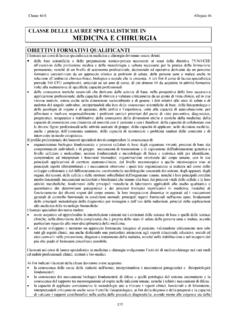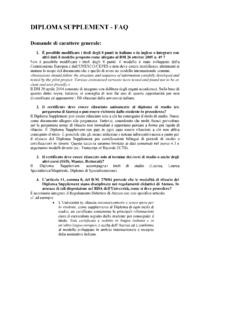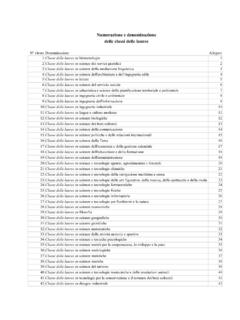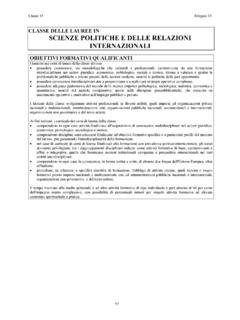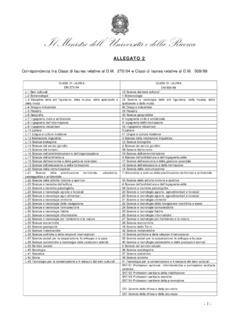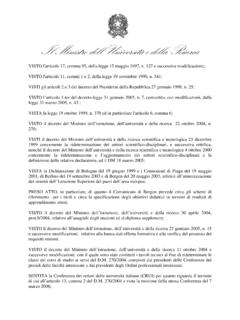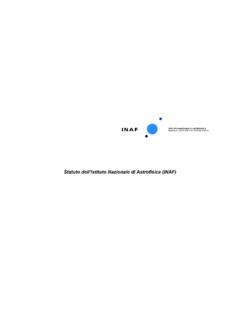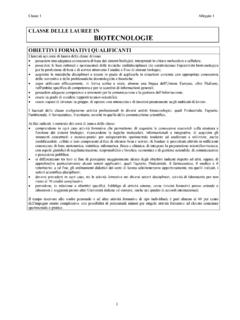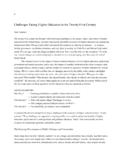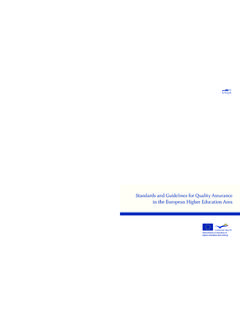Transcription of Italian Higher Education - Home - Miur
1 CIMEAITALIAN Higher EDUCATIONAn international guide Rome, 2003 Indexl 1. Higher Education IN ITALYl Higher Education : constitutional principles and aims2. THE UNIVERSITY Brief history and recent The new reform Objectives of the reform3. THE NEW UNIVERSITY SYSTEM IN The previous New academic degrees and Course Credit Entry Classification of Course offerings in Italian universities4. UNIVERSITIES IN List of University Teaching and research structures Teaching regulations5. MAIN INSTITUTIONAL Ministry for Education , University and National University Italian University Rectors National Council of University National Committee for assessment of the university system6.
2 NON-TRADITIONAL DELIVERY OF UNIVERSITY Distance learning7. NON-UNIVERSITY Higher Education in the arts and Reform in Academies of Fine Higher Institutes for Applied Music Conservatories and recognised Music National Academies and National Central Institutes for Cultural Schools for Archiving, Palaeography and Non-state artistic Education Non-university Higher Education in other Higher Schools for Language Institutes/Schools for Military Higher technical Education and training (IFTS) Regional Professional Education and Training (FPR)8. Italian LANGUAGE AND CIVILIZATION Courses Italian Cultural Dante Alighieri Courses in Italian Dante Alighieri Society9. ANNEXESA) List and addresses of Italian universitiesB) University system: 1999 reform lawC) Useful websites 1.
3 Higher Education IN Higher Education : constitutional principles and aimsThe main principles that lay the foundations for the Italian Education system, and in particular Higher Education , are set down in the Italian Constitution that was adopted in 1947. Article 33 of the constitution states that .. art and science are free and the teaching thereof shall be free . In defence of academic freedom, the article also states that all Higher Education institutions have the right to establish their own regulations autonomously, within the limits set by national legislation .Furthermore, Article 34 of the constitution establishes the principle of the right of individual citizens to Higher Education : All those who can prove the necessary competency and commitment have a right to pursue the highest levels of Education , regardless of their financial means.
4 As defined by law, the main purpose of Higher Education , is twofold - to promote scientific progress of the nation and to provide all citizens with Education and training that will lead to employment. 2. THE UNIVERSITY Brief history and recent reformsIn Italy, as in other Western European countries, the tradition of university studies dates back to the Middle Ages (11th and 12th century), when groups of students and scholars founded universitates studiorum in cities such as Bologna and Paris. These universitates were corporations which were initially conceived to defend the rights and privileges of the two abovementioned categories. They soon developed into centres of cultural debate, study and research and were open to scholars and students of any nationality.
5 Subsequently, more universitates studiorum were created by popes, emperors or kings. The Universit degli studi di Napoli Federico II, for example, was founded in 1224 by Frederick II of Sweden and King of the following centuries, the universities of the many different states which made up the Italian peninsula were gradually turned into state institutions under the control of the respective public authorities and by the time Italy had been unified in 1861, this process was complete. A consequence of this process was the strongly centralised character of the Italian university system, a feature that despite reform in 1923 remained substantially unchanged until the late out of cultural tradition, partly due to political interests, university Education became to be seen more and more as a means to achieve Higher social status.
6 Consequently, in the sixties and the seventies social demand for university Education grew considerably and this massive increase in student numbers meant that reform was necessary. A significant reform process started in 1989, marking the first step towards the decentralisation of the university sector. The Ministry for Universities and Research (Ministero dell Universit e della Ricerca Scientifica e Tecnologica - Murst) was set up as a separate body from the Ministry of National Education (Ministero della Pubblica Istruzione - MPI), which until then had been responsible for all educational levels from primary to tertiary. It asserted the principle of university autonomy in management, financial and budgetary issues, teaching (organisation of degree courses along with all related teaching/learning services) and new Ministry s role consisted primarily in defining and coordinating general policy for university Education , promoting and planning research and overseeing Italian participation in European Union and international programmes for university Education and research.
7 A complex decentralisation process took place in the period 1990-1998 which resulted not only in the implementation of full institutional autonomy for universities, but also in a significant number of transformations and innovations leading to the creation of new types of faculties and degree courses, reorganisation of student welfare services and the introduction of a quality assurance system. It redefined the rules and procedures for the recruitment of academics and reorganised doctoral studies, abolishing the national selection procedures for admission. It also sought to decongest overcrowded universities with the establishment of 9 new Higher Education institutions. The new reformIn addition to the changes and innovations that were implemented in the university sector in this period, an even more substantial reform was recently approved in 1999 and introduced with the academic year 2001/2.
8 The main purpose of the reform was to grant full autonomy to universities for management and finance as well as for teaching and course reform has taken into account the principles of the Sorbonne Declaration (signed on 25 May 1998 by the Ministers of Education of 4 EU countries, namely France, Italy, Germany and the United Kingdom) and the Bologna Declaration (a joint statement of 31 European Ministers of Education signed on 19 June 1999) whichpromote the creation of a European Higher Education Areathrough the harmonisation of the different European educational systems. The ministerial decree No. 509 of 3rd November 1999 laid down the general criteria to be adopted by universities in the reorganisation of their degree courses and established the types of degrees and qualifications that universities are allowed to reforms introduced since the end of the eighties have often been complex procedures and have often met with resistance or concern from the different parties involved.
9 However, these reforms have been essential in order to transform the old elite university system into one of wider access.(In the last 50 years, enrolments in Italian universities have increased by 700% reachinga total of students.)In order to guarantee both quantity and quality, it has therefore been necessary to review the entire university system in the light of needs expressed by very different users with different abilities and , innovative teaching methods, tutoring, student welfare, professional qualifications and internationalisation are some of the new tasks that Italian universities must take on today and which are transforming their traditional relationship with the student process of change does not concern only teaching and student is a far reaching transformation taking place within the very structure of the university itself and in its relationship with society and the local community.
10 Today s society places many pressing, and at times contradictory, demands on Education and training providers. They are expected to provide solutions to the problems of competitiveness, unemployment and marginalisation, and to play a part in overcoming the challenges of dramatic transformation in our sees Education as an active tool in the labourmarket able to curb unemployment especially among young people, to increase competitiveness and disseminate technology. Italy has set a number of Higher Education objectives which seek to bring it in line with the other industrialised countries of the European Union: an increase in studentenrolments in Higher Education , a reduction in drop out rates, an improved geographical distribution and social spread, as well as better student support and welfare number of measures have been introduced to offer a wider variety ofhigher Education pathways, including the new Higher technical Education and training sector, (Istruzione e Formazione tecnica superiore - IFTS) to solve the problems of overcrowding in the very large universities and to set up a national evaluation system linked to an incentive policy for the distribution of key that brought about a change in attitude before organisational change took place was university autonomy.
